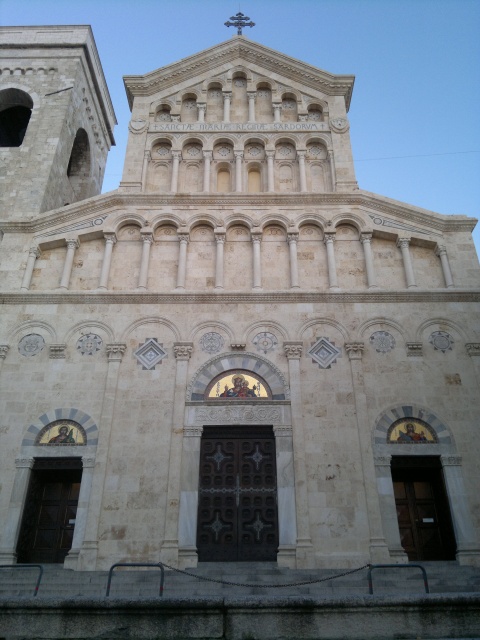Built in the 13th century in the Pisan-Romanesque style, it later underwent trasformations in the Gothic, Baroque and Neo-Romanesque style.
The Cathedral of Santa Maria was built in the XIII century in Roman style by the Pisans. It became the Cathedral after conquering and the subsequent abandonment of the previous seat of the bishop’s palace Santa Igia, capital of the Giudicato of Cagliari.
The only original parts still visible are the bell tower, the decorated architrave on top of the central gate and the transept arms of the lateral gates that belong though to the XIV century. The remainder of the building is fruit of various restoration works that have gone on through time.
The restoration that went on between 1699 and 1709 by architect Pietro Fossati entirely rebuilt the façade in Baroque style, in accordance with that era’s taste. Another restoration at the beginning of the 1900’s tore the Baroque façade down, hoping to find the original Roman façade that was thought to be found underneath: not having found the original Pisan façade, the church remained for many years without and only in 1933 was completely rebuilt by taking example from Santa Maria dei Miracoli in Pisa.
The original bell tower resembles the defensive towers of the quarter and dashes up on the left side of the façade, decorated with suspended archers. Built in the 13th century, it is 36 metres high, about 130 metres above sea level. To get to the top, you have to climb 137 steps through its wooden structure. It's great exercise, isn't it? Once there you can admire stunning views of the city and its four great bronze bells, still used to mark the hours and call worshippers to the Mass.
In the XIV century the transept was added, only the two lateral gates were left, this shows the passing from roman to gothic style: the northern facing gates still holds its roman style, the other is gothic. They are both very beautiful, and are decorated with carvings in the white stone. It is possible to visit the inside of the Cathedral
The church plan has a cruciform shape (cross shaped); it is divided into three naves, with lateral chapels, transept and raised presbytery. The chapels are dedicated to different saints and are more or less in baroque style. The oldest chapels are found at the sides of the altar and differentiate themselves from the others by the simplicity of the white stone from which it was made, the moderate neo-Gothic style and the characteristic double lancet window that lights up the area. The two chapels were hidden by restoration work that went on during 1664 and 1674 and were brought back to light during more restoration in the 1900’s. The chapel on the right side of the altar is in Gothic-Aragonese style and once a year, on 15 August, hosts one of the thorns of Jesus’ crown donated by Pope Clement VII: today it is decorated by beautiful silver art from the 1500’s like a candelabra and an tabernacle in the form of a temple. Here the archbishop Ernesto Maria Piovella is buried.
The chapel on the left of the altar is dedicated to the “Sacred Heart of Jesus” and dates back to the Pisan era.
Next to it you can admire the Mausoleum of Martino il Giovane, Aragonese conquistador of Sardinia. The monument is made from intarsia marble that characterizes the whole church, in red, white and black.
The altar is found on an elevated quadrangular presbytery with a crypt underneath. At the feet of the presbytery one can notice four lions clinching different pray in their mouths (a bear, a human, a dragon and a bull): they were initially part of what is considered to be the feather in the cap of the Cathedral, in other words the pulpit of Mastro Guglielmo.
Today the pulpit is divided into two parts and is found on the sides of the entrance gate: it was built for the Dome of Pisa in 1160 and then given to Cagliari in 1312 when the Aragonese were already at the gates. This gift, a masterpiece of medieval art, wanted to strengthen the ties between Pisa and the Castle of Cagliari and therefore expresses the importance that this city had for the Tuscany city as a strategic point of commerce.
It is entirely decorated with scenes taken from the Bible, but the characters are wearing medieval clothing: the represented scenes appear very aggressive due to the technique of sculpting in protruding and perforating of the eyes of the characters.
At the opposite sides of the presbytery, two doors allow you to enter the crypt. It was built by Monsignor Desquivel in 1618 to contain the remains of the martyrs found in the necropolis of San Lucifero and San Saturnino in Cagliari.
Cattedrale di Santa Maria e Torre Campanaria
Cattedrale di Santa Maria e Torre Campanaria
Piazza Palazzo
City
CagliariAdd new review
Your review will be visible after approval by the editors
To post a review you must be an authenticated user.
Log in with Social Login
